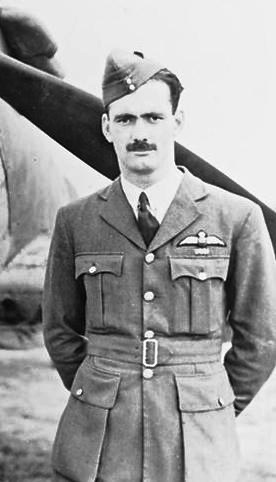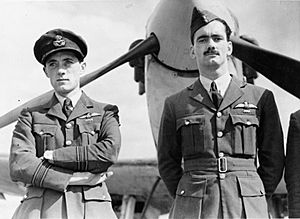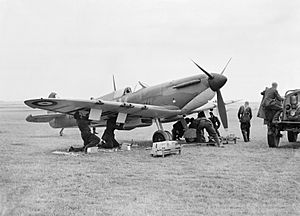Wilfred Clouston facts for kids
Quick facts for kids
Wilfred Clouston
|
|
|---|---|

Wilfred Clouston, September 1940
|
|
| Nickname(s) | Wilf |
| Born | 15 January 1916 Auckland, New Zealand |
| Died | 24 May 1980 (aged 64) Waipukurau, New Zealand |
| Allegiance | New Zealand |
| Service/ |
Royal Air Force |
| Years of service | 1936–1957 |
| Rank | Acting Group Captain |
| Commands held | No. 258 Squadron No. 488 (NZ) Squadron RAF Northolt |
| Battles/wars | Second World War |
| Awards | Distinguished Flying Cross |
Wilfred Greville Clouston (1916–1980) was a brave New Zealand pilot. He was a "flying ace" for the Royal Air Force (RAF) during World War II. This means he shot down many enemy planes. He was officially credited with destroying nine enemy aircraft. He also helped destroy three more.
Wilfred, known as Wilf, was born in Auckland, New Zealand. He joined the RAF in 1936. He flew Supermarine Spitfires during the Battle of France and the Battle of Britain. Later, he led his own squadron. In 1941, he went to Singapore to lead a New Zealand squadron. He became a prisoner of war when Singapore was captured in 1942. After the war, he stayed in the RAF until 1957. He then became a farmer in New Zealand until he passed away in 1980.
Contents
Early Life and Flight Training
Wilfred Greville Clouston was born in Auckland, New Zealand, on January 15, 1916. His parents were Allan and Vivienne Clouston. He had a younger brother named John. His family later moved to Wellington. Wilf finished his schooling at Nelson College. After school, he worked as a clerk.
Wilf loved flying. He took flying lessons at Rongotai Aerodrome. In 1935, he earned his pilot's licence. The next year, he traveled to England. There, he joined the Royal Air Force (RAF).
Joining the RAF
Wilf started his RAF training at RAF Uxbridge. Then he went to the No. 7 Flying Training School RAF at RAF Peterborough. After earning his pilot's "wings," he joined No. 19 Squadron RAF in June 1937. The squadron was based at Duxford Aerodrome. They flew Gloster Gauntlet planes.
In August 1938, No. 19 Squadron became the first RAF squadron to get Supermarine Spitfire planes. While learning to fly the new Spitfire, Wilf had a mid-air crash with another Spitfire. Luckily, both pilots landed safely.
World War II Service

When World War II began, No. 19 Squadron was still at Duxford. Their job was to protect ships in the North Sea. They flew missions to cover convoys. In May 1940, Wilf and his team chased a Junkers Ju 88 bomber. They could not shoot it down. Around this time, Wilf married Anne Hyde. Her father was an admiral in the Royal Navy.
Fighting Over France and Dunkirk
Soon after Germany invaded nearby countries, No. 19 Squadron began flying missions over France and Belgium. They flew from airfields in southern England. The fighting became very intense in late May 1940. British soldiers were trapped around Dunkirk. RAF fighter squadrons protected them from the air.
On May 26, 1940, Wilf, now a flight lieutenant, led his flight over Dunkirk. They met about 20 Junkers Ju 87 dive bombers and their escort fighters. Wilf shot down two Ju 87s. The next day, he shot down a Dornier Do 17. He and two other pilots probably destroyed another. On June 1, over Dunkirk again, he helped destroy a Messerschmitt Bf 110. He also shot down a Messerschmitt Bf 109 by himself.
The RAF stopped protecting Dunkirk after the soldiers were evacuated on June 4. Later that month, Wilf received the Distinguished Flying Cross (DFC). This award was for his bravery. The official announcement praised his actions.
The Battle of Britain
No. 19 Squadron moved to RAF Fowlmere, near Duxford. They were part of No. 12 Group RAF. This group protected the Midlands region of England. In June, the squadron tried out Spitfires with new cannons. But these cannons often jammed.
As the Battle of Britain grew, No. 19 Squadron joined the "Duxford Wing." This was a large group of five squadrons. They were often sent to protect airfields of No. 11 Group RAF. On August 9, Wilf flew a cannon-equipped Spitfire. He was credited with half shares in two Bf 109s shot down over the Thames Estuary. Despite some success, the squadron went back to Spitfires with standard machine guns in September. The cannons jammed too often.
On September 9, Wilf destroyed one Bf 109. He also claimed another as probably destroyed. On Battle of Britain Day, September 15, 1940, the Duxford Wing was sent to help. They met a large German bombing raid over London. Wilf led his section and found a group of Do 17s. He managed to destroy one. Later that day, during another German raid, he shot down a second Do 17. A few days later, he destroyed a Ju 88 over the Thames Estuary.
Leading a Squadron
In November 1940, Wilf was promoted to squadron leader. He became the commander of No. 258 Squadron RAF. This new squadron was based in Yorkshire. Most of its pilots were from New Zealand. They flew Hawker Hurricanes.
The squadron first protected convoys along the north-east coast. Then they moved to RAF Jurby on the Isle of Man. From there, they patrolled to stop German bombers attacking English ports. In May 1941, the squadron moved to south-east England. They began escorting bombers on missions into France.
During one mission, escorting Bristol Blenheims to a petroleum plant in Gosnay, Wilf was hurt. A Bf 109 attacked his Hurricane. He was still able to fly back to RAF Kenley. His brother John also joined the squadron for a time. John had joined the Royal New Zealand Air Force (RNZAF) in 1940. Sadly, John was killed in July 1944. He was shot down on D-Day and became a prisoner. His prison transport was later attacked by American fighters.
Singapore and Prisoner of War
By August 1941, the British government saw a growing threat from Japan in Asia. New Zealand was asked to help protect British Malaya. So, the RNZAF sent pilots to form a new fighter squadron in Singapore. Wilf, as an experienced leader, was ordered to command this squadron. It was named No. 488 Squadron RNZAF. His wife went to New Zealand to live with his parents.
Wilf arrived in Singapore on September 19, 1941. The rest of the squadron arrived on October 10. They were based at Kallang Airport. They began to fly Brewster Buffalo aircraft. Wilf worried that the Buffalo was not a good fighter plane. He worked hard to get the squadron ready for battle.
When Japan attacked British Malaya in December 1941, the squadron was still training. They started flying patrols to find Japanese planes. But the Buffaloes were not good enough. They could not fly high enough. When they met Japanese fighters in January 1942, the Buffaloes' poor performance became clear. Many planes were lost to Japanese fighters and bombing raids.
On January 23, 1942, Wilf was moved to RAF headquarters in Singapore. He worked in the operations room. Another pilot, John Noble MacKenzie, took over No. 488 Squadron. During the final days of the Battle of Singapore, the squadron's pilots were evacuated. The ground crew prepared a Hawker Hurricane for Wilf to escape. But he left on a boat with other RAF staff. This boat was sunk by a Japanese bomber. He was rescued by another ship, but it was stopped by the Japanese the next day. Wilf became a prisoner of war (POW). Before his capture, he helped the remaining ground crew escape Singapore.
Wilf was held in a POW camp in Palembang, Sumatra, for most of the war. By the time Japan surrendered in September 1945, he was at Changi Prison in Singapore. He was suffering from poor health when he was released.
Life After the War
After returning to England, Wilf stayed in the RAF. He became commander of RAF Turnhouse. In July 1950, he was promoted to wing commander. He held many different jobs in the RAF after the war. These included working at Fighter Command and commanding RAF Khormaksar in Aden. His last job was as commander of RAF Northolt. He reached the rank of acting group captain.
Wilf retired from the RAF in 1957 and returned to New Zealand. He started farming in Waipukurau, in the Hawke's Bay Region. His health got worse in his later years. This was due to his time as a prisoner of war. His son took over the farm, which was named Tangmere. Wilf moved into town. He died on May 24, 1980, after a fall at his home. He was 64 years old.
Wilf Clouston was a true hero. He is remembered for destroying nine enemy aircraft. He also helped destroy three more. He probably destroyed one more enemy plane and shared in another probable.
Images for kids





